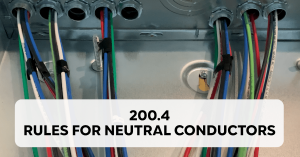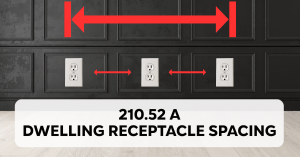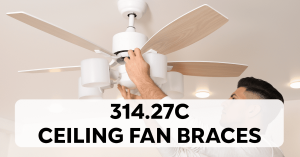1 Topics
Dwelling Receptacle Spacing – 210.52A
In this video, you will learn about the crucial aspects of receptacle spacing as dictated by the National Electrical Code, specifically section 210.52 A. This detailed guide will help you understand the rules for placing receptacles in various room types, including the rationale behind these codes. By focusing on practical scenarios and interpretations, the video equips electricians and students with the knowledge to effectively design room layouts while ensuring compliance with NEC standards, particularly for common appliances and room configurations.
1 Topics
Ceiling Fan Braces 314.27(C) – 2020 NEC
In this video, you will learn about the National Electrical Code (NEC) requirements for ceiling fan installations, focusing on the specifications for outlet boxes used to support ceiling fans. The video delves into the details of weight limits, the importance of using fan-rated outlet boxes, and the required markings for boxes supporting fans over 35 pounds. Additionally, it provides insights into the different types of fan-rated outlet boxes, such as the fan-rated pancake box, and the critical role they play in ensuring safe and compliant ceiling fan installations.
1 Topics
Motor Conductor Sizing Examples – 2020 NEC
In this video, we delve into the intricacies of sizing motor conductors, a crucial aspect of electrical installations. You will learn how to correctly size conductors for different types of motors, including single-phase and three-phase systems, under various operational conditions such as continuous and intermittent duty. The course emphasizes adherence to the National Electrical Code (NEC) standards, ensuring safety and efficiency in electrical installations.
1 Topics
Motor Conductor Sizing – 2020 NEC
In this video, you will learn about the intricacies of motor conductor sizing in accordance with the 2020 National Electrical Code (NEC). The course goes into the crucial aspects of determining the correct ampacity for conductors in various motor applications, including continuous duty motors. Additionally, the video explains the characteristics of motors under different duty types, such as periodic duty, and their impact on conductor sizing.
1 Topics
Motor OCPD Sizing Examples
In this video, you will learn about the critical aspects of motor Overcurrent Protection Device (OCPD) sizing, including how to accurately calculate the correct size of breakers and fuses for motor protection. The course explains the importance of following National Electrical Code guidelines and provides practical examples to demonstrate the correct application of these rules. You will gain a thorough understanding of how to select the right OCPD based on motor full-load amperes (FLA) and the nuances of handling different types of motors, ensuring both safety and efficiency in electrical installations.
1 Topics
Motor OCPD Sizing
In this video, you will learn about the intricacies of sizing Overcurrent Protection Devices (OCPDs) for motors, a crucial aspect of electrical installations. The course delves into understanding motor Full Load Current (FLC), service factors, and the implications of locked rotors. It emphasizes the importance of correctly sizing breakers and overloads for motor protection, catering to various motor types and operational conditions.
1 Topics
Why We Bond Neutrals and Grounds Together
In this video, "Why We Bond Neutrals and Grounds Together," you will learn about the critical safety and functional reasons for bonding neutral and ground wires in electrical systems. This in-depth explanation covers the principles of fault clearing, ensuring safety for both the electrical system and its users. The video highlights the importance of maintaining a consistent potential across all metal parts and the role of grounding and bonding in preventing electric shocks and equipment damage.
1 Topics
Overhead Service Requirements – 230.24 through 230.28
In this video, you will learn about the crucial safety guidelines for working with electrical conductors, particularly focusing on the required clearances for overhead service conductors in various scenarios. The course delves into the National Electrical Code (NEC) requirements, providing insights into the minimum vertical clearances for conductors above roofs with different slopes and the specific clearances required above areas or sidewalks accessible only to pedestrians. These guidelines are essential for ensuring the safety and compliance of electrical installations in residential and commercial settings.










